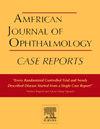视网膜上膜自发分离伴视网膜血管母细胞瘤:1例随访10年
Q3 Medicine
引用次数: 0
摘要
目的报告1例视网膜血管母细胞瘤并发继发性视网膜前膜(ERM)自发分离,并对其进行激光光凝治疗(PC)后的长期随访。38岁男性,左眼视力下降1个月(20/32),诊断为视网膜血管母细胞瘤继发的ERM。虽然最初计划进行PC,但他要求推迟治疗。一个月后,我们的检查显示ERM自发分离并后玻璃体脱离。他的视力从20/32提高到20/20。随后对供血血管和成血管细胞瘤行PC检查。我们对该患者进行了12年的随访,目前他的视力为20/16,无其他并发症或ERM复发。结论和重要性继发性ERM的自发分离可以在任何治疗之前发生,功能和解剖恢复迅速。我们的研究结果表明,临床医生需要评估与血管母细胞瘤相关的二次erm的治疗方案。本文章由计算机程序翻译,如有差异,请以英文原文为准。
Spontaneous separation of epiretinal membrane associated with retinal hemangioblastoma: a case report with 10-year follow-up
Purpose
To report a case with a spontaneous separation of a secondary epiretinal membrane (ERM) associated with a retinal hemangioblastoma, and its long-term follow-up after laser photocoagulation (PC) for the hemangioblastoma.
Observations
A 38-year-old man presented with a one-month history of decreased vision in his left eye (20/32) and was diagnosed with an ERM secondary to a retinal hemangioblastoma. Although PC was initially planned, he requested that the treatment be postponed. One month later, our examination showed a spontaneous separation of the ERM with a posterior vitreous detachment. His visual acuity improved from 20/32 to 20/20. PC was performed on the feeding vessels and hemangioblastoma later. We have followed this patient for 12 years, and his visual acuity is currently 20/16 without other complications or a recurrence of the ERM.
Conclusions and importance
A spontaneous separation of a secondary ERM can occur before any treatment with a rapid functional and anatomical recovery. Our findings indicate that clinicians need to assess the treatment options for secondly ERMs associated with a hemangioblastoma.
求助全文
通过发布文献求助,成功后即可免费获取论文全文。
去求助
来源期刊

American Journal of Ophthalmology Case Reports
Medicine-Ophthalmology
CiteScore
2.40
自引率
0.00%
发文量
513
审稿时长
16 weeks
期刊介绍:
The American Journal of Ophthalmology Case Reports is a peer-reviewed, scientific publication that welcomes the submission of original, previously unpublished case report manuscripts directed to ophthalmologists and visual science specialists. The cases shall be challenging and stimulating but shall also be presented in an educational format to engage the readers as if they are working alongside with the caring clinician scientists to manage the patients. Submissions shall be clear, concise, and well-documented reports. Brief reports and case series submissions on specific themes are also very welcome.
 求助内容:
求助内容: 应助结果提醒方式:
应助结果提醒方式:


